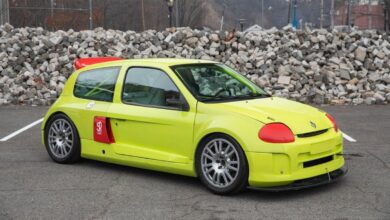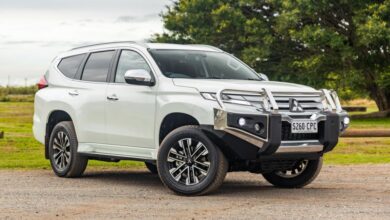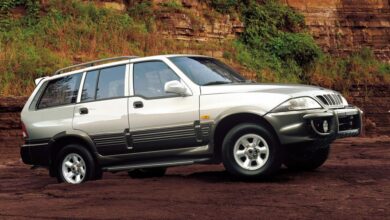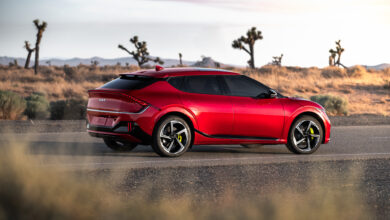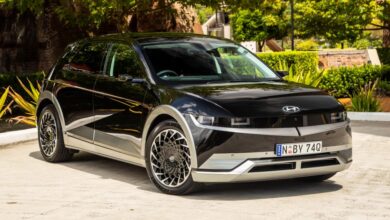The VinFast VF8 Isn’t Ready for America
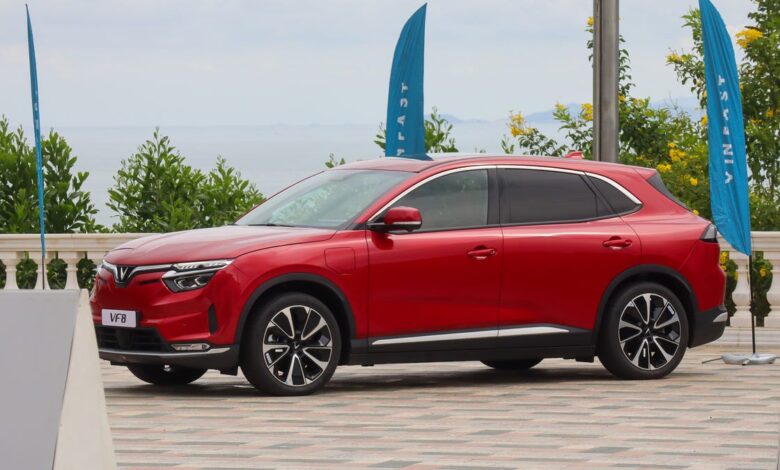
I took out my phone and began frantically taking pictures of my passport as the hundred-person-plus customs line inched forward. “You’ll get your passport back a little later,” someone at the head of the line told me. ”They’re going to hold on to them for a while.”
I wasn’t sure if this person was an influencer, a journalist I didn’t recognize, or a VinFast employee. But it’s not like I had a choice. I mean, what was I going to do? The Vietnamese customs agent looked me up and down and put my passport in a pile with all the others.
By the end of this trip, sending my passport into the ether wouldn’t even rank among the top 10 craziest things I’d be privy to.
I was in Vietnam to sample the automotive fruits of VinFast; the fast-moving automotive startup had just begun selling electric cars in its home country and was already promising to bring them to the United States. I definitely learned something about VinFast, but it wasn’t exactly what the company wanted me to see.
Full Disclosure: VinFast flew me from Columbus, Ohio, to San Francisco, put me in a really nice hotel for one night, then flew me and at least 100 other journalists, influencers, YouTubers, TikTokers, VinFast reservation holders (called VinFirst), VinFast employees, and other persons of interest from SFO to Vietnam on a chartered plane, all so we could sample the company’s new EVs. We stayed at two private-island resorts and spent a night in Hanoi at the same hotel where Donald Trump and Kim Jong Un met for the first time.

Eventually, after a bus ride, shower, and nap, my passport was returned. Soon after that, I was on a yacht in the middle of Ha Long Bay while excited VinFast employees toasted to the company’s success seemingly every 45 seconds. The song “Glad You Came” by The Wanted blared. I was jet-lagged and exhausted; the bountifully sweet Vietnamese iced coffee did nothing to allay the unique fatigue that comes from crossing the international date line. This off-kilter feeling would stick with me throughout my entire trip.
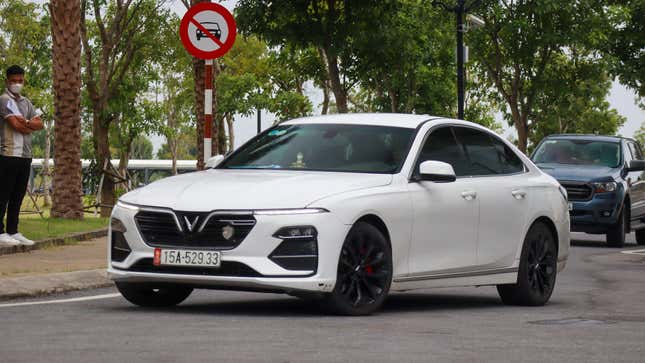
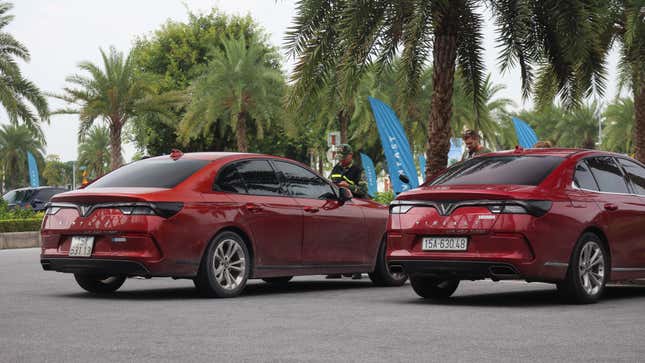
VinFast came onto the car scene in 2017. Its first products were rebodied vehicles from major automakers, styled by Pininfarina and intended to be sold both in Vietnam and the United States. The VinFast Lux A 2.0 was based on the BMW 530i, the VinFast Lux SA 2.0 was a modified BMW X5, and the subcompact VinFast Fadil was a restyled Chevy Spark. The limited-run 500-unit President SUV was a Lux SA with a General Motors V8 under the hood in place of the BMW engine.
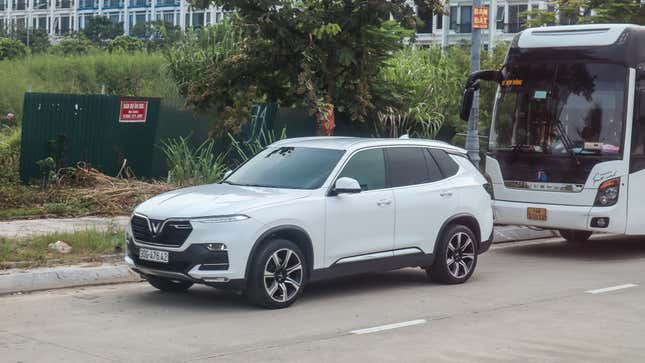
VinFast’s efforts were strong enough to rocket the brand to the top of the Vietnamese sales charts, not bad for a company that didn’t start selling cars until 2019. They aren’t cheap, either: a base VinFast Lux SA 2.0 would retail for the equivalent of more than $68,000 — pricey, but also about a third of what an imported BMW X5 would cost in Vietnam. In July 2022, the recently-canceled Lux A 2.0 doubled the Vietnamese sales figure of the Kia K5, Toyota Camry, Mazda 6, and Honda Accord combined. (Plans to sell these early VinFast models in the US by 2021 never materialized.)
In January 2022, VinFast announced its intention to end production of internal-combustion vehicles and shift to a full EV lineup. Gone would be the BMW- and GM-based designs, replaced with electric vehicles developed from the ground up by VinFast. The company poached top-tier engineering talent, including former GM employees who had worked on the revolutionary Ultium EV platform.
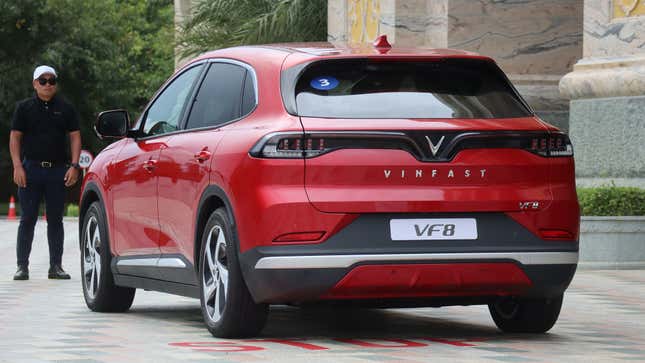
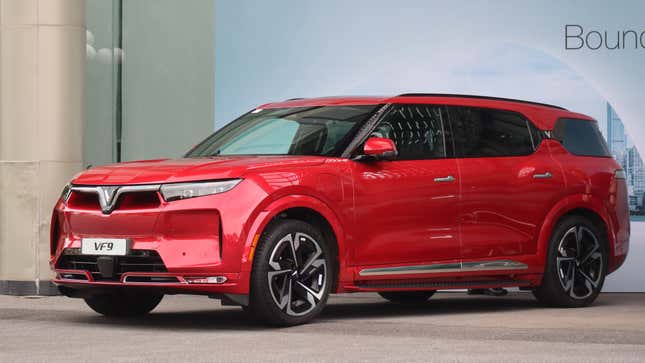
The brand’s self-imposed timeline was very short. While showing a full line of production-intent EV concepts at CES in January 2022, the brand claimed it would stop selling its ICE vehicles by the end of this year, despite only introducing its first models in 2019. At the time, VinFast claimed it would have at least two fully-electric models, the VF8 and VF9, on American roads by year’s end. Ambitious, but for a while everything seemed to be on track: By early July, the brand had opened its first retail locations in California. The company had already put one EV, the VinFast e34, on the Vietnamese domestic market, only three months after announcing it was stopping ICE production. By mid-July 2022, the company had stopped taking orders for its ICE vehicles entirely. Clearly, it wasn’t just talk.
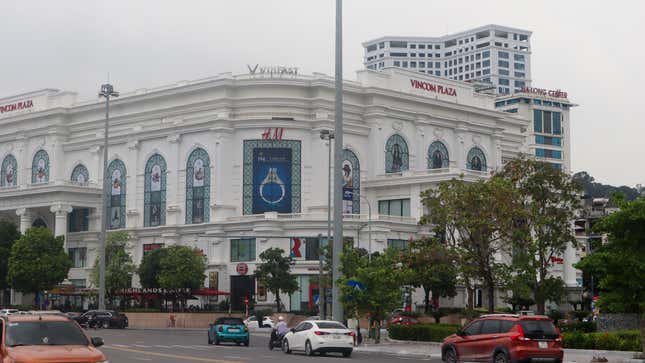
VinFast is just one division of an enormous parent company, the billion-dollar conglomerate known as Vingroup, headed by one man, Pham Nhat Vuong. Born in 1968, the businessman grew up in Hanoi, graduating in 1992 from Russia’s Moscow Geological Prospecting University. Pham made his fortune mass-producing instant noodles in an enterprise that was eventually sold to Nestle. Eventually, he expanded into real estate, building a business that turned him into Vietnam’s first billionaire.
Vingroup has businesses all over Vietnam. You might buy groceries at VinMart and clothing at VinPlaza. Your family vacations might be at a Disney-style VinWonder theme park, or you might book a grown-up getaway at a VinPearl resort. Your phone might be a VinSmart. Your office might be owned by Vincom Office, your house or apartment building part of VinHomes. Your child could be born at a VinMec hospital, attend VinSchool, and upon graduation, matriculate at the recently-launched VinUniversity. The setup feels like a modern spin on the 19th-century American company town, but it’s not dissimilar to what Samsung and Hyundai did in South Korea in the 1990s.
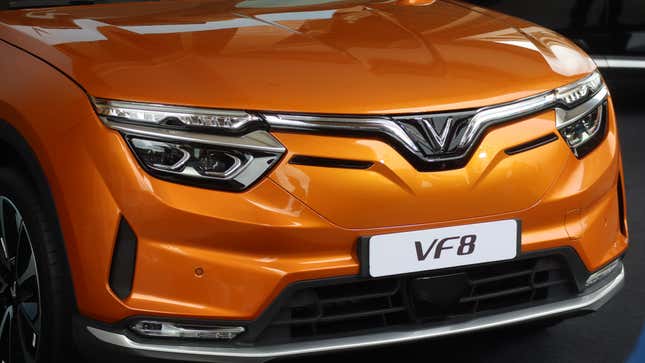
In July of this year, I poked around at an early pre-production VinFast VF8 at the company’s showroom in San Mateo. At the time, VinFast was pushing an unusual pricing model. See, the VF8 and VF9 wouldn’t actually come with batteries. The target base price of $39,999 for the VF8 was attractively low because you’d have to lease the battery from VinFast. The battery pricing would change based on how much you wanted to drive: For around $55 per month, you’d get a piddly monthly allowance of 310 miles. An unlimited-mile battery lease would cost upwards of $130 per month for as long as you wanted to drive the car. (Since my showroom visit in July, it appears the brand has dropped the limited-mile option, asking customers to pay $169 per month for unlimited mileage in the VF8 or $219 per month in the VF9.)
I explored the Bay Area showroom, fiddling with the VF8 and asking questions about the pricing scheme. I didn’t think the car on display was all that great, but it was clearly in pre-production guise, full of oddly-fitting trim, missing pieces, and weird materials that felt undecided.
The sales staff were nice enough, but neither they nor any other VinFast representatives I contacted could answer any hard questions about how the brand planned on enforcing the battery lease program. How would they know if you drove more than 310 miles? What happens if you don’t pay the battery lease? Even now, getting any detailed price info from the VinFast website seems to require a $199 deposit and waiting for a VinFast concierge to call you and spec out your car.

Still, I stayed open-minded. The brand had opened stores barely six months after announcing its intent to sell EVs in the U.S. I wanted to know more, so I emailed the company’s U.S. public relations team and asked them to keep me posted if VinFast was planning any launch events in America.
Two days later, the company invited me to Vietnam.

On September 18, I joined a group of nearly a hundred journalists, influencers, hopeful VinFast customers, and employees on a chartered flight from San Francisco to Vietnam. Our group crossed the international date line and deplaned near Ha Long Bay, a UNESCO World Heritage Site. From the airport, we took a bus and a boat to VinPearl Ha Long Bay, a resort on a private island owned by Vingroup.
I had done my research before the trip. I knew Vingroup was big. But at that moment, I realized I had vastly underestimated how powerful this company was, not to mention its insistence on flair and over-the-top opulence. “I don’t think Elon or Peter Rawlinson have their own island resort,” I muttered to myself. The scope of this undertaking was monumental: Prior to my group’s arrival, VinFast had hosted three prior tours like this for journalists and fans.
After a little rest, VinFast ferried our group to a yacht in Ha Long Bay for an opulent welcome dinner, abuzz with VinFast representatives and employees excited to tell us about the brand and the itinerary for our visit.
“We are pleased to announce that the VinFast VF8 was completed a whole two months ahead of schedule,” a VinFast representative said. She also told our group that the VF8 had received official Vietnamese sales approval a mere two days before we had arrived, implying the model was damn near ready for production.
I had heard from other automotive journalists that initial driving impressions on the VF8 revealed a very unfinished product. Still, I vowed to keep an open mind: Vehicle development is a process, and VinFast’s hosted events had been going on for nearly three months. Lots of improvements can happen in a short amount of time, and the brand is obsessed with moving fast. I reminded myself there was a real possibility that VinFast would have a much more complete vehicle for us to look over.
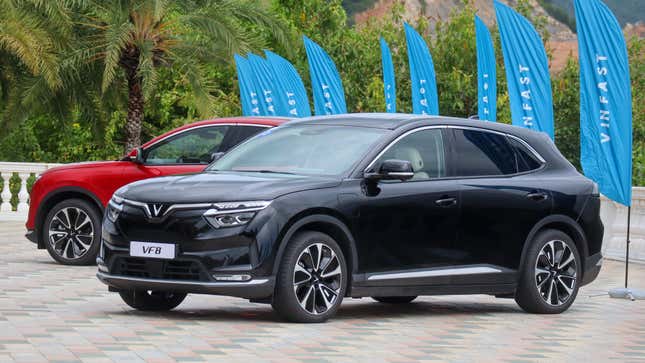
Our chance to drive the VF8 wouldn’t be for a few days, though. Until then, VinFast had more of Vietnam to show us. It’s hard to conceptualize the scale of VinGroup, but luckily the VinFast team was there to demonstrate for us what the brand had achieved all over Hanoi. The next day, we were whisked out of Ha Long Bay to VinFast’s manufacturing facility and global headquarters a little over an hour away in the city of Hai Phong.
Like Tesla, VinFast is gunning for a vertically integrated manufacturing model, keeping most aspects of vehicle production in-house. VinFast’s factories are brand new, full of gleaming equipment. Although the company had announced the end of production of its internal-combustion vehicles, when our group arrived at the factory the last batch of BMW-based sedans was being assembled to fulfill old orders. And while the VF8 and VF9 production lines were up and running, it didn’t seem like much work was being done during our factory tour. Some stations were unmanned, and it felt like there were only one or two teams doing anything of interest in the entire manufacturing facility. It seemed like there was far more urgency and effort on the line producing VinFast’s e-scooters.
“Hey, where is everyone?” I asked a VinFast representative.
“Oh, they’re on lunch!” the rep told me.
It was 10 a.m.
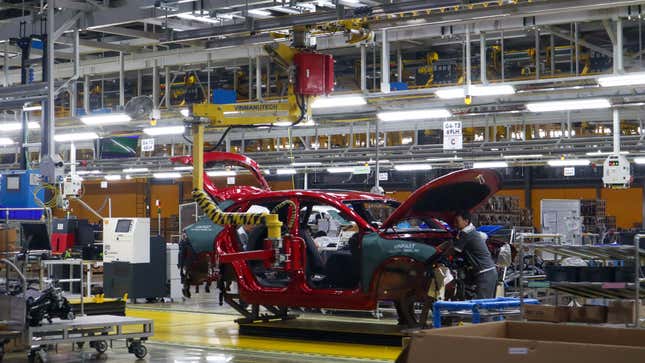
Despite the oddness, I was impressed. It really seemed like the company was on track to start mass-producing electric cars. Body panels were being stamped, and VF8s and VF9s were being assembled. The facility was surrounded by parking lots full of brand-new cars, and a VinFast representative on the tour assured us the VF8 was just a few regulatory hurdles away from being approved for U.S. sale.
After lunch, it was time for a roundtable discussion with VinFast’s Global CEO Le Thi Thu Thuy. I finally had a main line to the lady in charge. There wasn’t a hell of a lot I could ascertain from a dinnertime PowerPoint and a factory tour; here, I could ask some pointed questions about VinFast’s battery leasing scheme.
Ms. Le insisted that, although VinFast remained committed to the battery subscription plan, the company had decided to add a purchase option. That was news to me; even when I confirmed my flight tickets, the batteries were still subscription-only. I checked the VinFast website on my phone. Sure enough, the company had quietly added a battery purchase option, and raised the price of the cars. As of this writing, a base VF8 starts at $42,200, or $57,000 if you decide to purchase the battery outright; the VF9 will start at $57,500 with a battery subscription, rising to $76,000 if you buy the battery. Yikes.
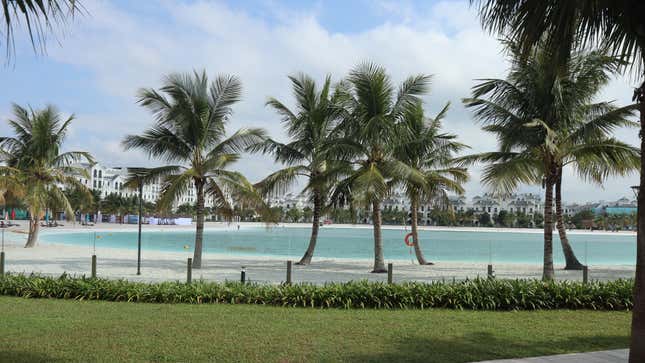
After our factory tour, company reps brought us to Ocean Park, one of Vingroup’s housing developments. Just outside of Hanoi, Ocean Park and its sister sites Ocean Park 2 (The Empire) and Ocean Park 3 (The Crown) resemble small cities in scale. Ocean Park was vast; a plot of land on the other side of the Red River Delta from Hanoi, filled with high-rise condo complexes, two- and three-story homes, and a water park with one of the biggest wave pools I’ve ever seen.
It was impressive in its scale, but I couldn’t help but notice, much like the factory, fully-finished parts of Ocean Park felt empty. Stores were open, and some homes were occupied, but compared to the hustle and bustle of Hanoi, Ocean Park was downright desolate. Most of the traffic seemed to come from construction workers pouring concrete, paving roads, and building Ocean Park’s high rises. The two- and three-story homes seemed mostly empty.

The barren, slightly uncanny feeling didn’t go away with our tour of VinUniversity, located in Ocean Park. The campus is brand-new, full of ornate marble pillars and neo-renaissance style statues dotting the spotless campus. Vingroup partnered with Cornell University to craft a “world-class” school, and while VinUni students aren’t required to work for Vingroup upon graduation, the courses offered seem like they’re designed to create a supply of employees for the corporation.
The VinUni website makes that clear:
VinUni is proud to be a part of the Vingroup ecosystem, giving our students opportunities to connect with several reputable research institutes (such as VinAI, VinBrain, and Vin BigData), pioneering industrial enterprises (such as VinSmart and VinFast), and leading Vietnamese companies (such as Vinpearl, Vincom Retail, Vinmec, and Vinhomes).
As uncanny as everything felt, I understood what the brand was trying to do. As a developing nation, Vietnam has its foot on the gas. There’s a growing middle class that needs homes, schools, and infrastructure. And, of course, cars.
But man, my open-minded outlook was starting to falter. I came to Vietnam to understand VinFast and the cars it hoped to rush onto the U.S. market. But so far, I hadn’t really learned anything except that Vingroup is a powerful entity, one that wants to compete on the world stage. It was clear the company wanted us to see its ability to do great things, but also control the narrative around Vingroup’s interests, and Vietnam as a whole.

There’s no better example of this than what happened the next morning. Before our afternoon test drive, we had some downtime. Being on a private island, there’s no real way to leave without permission. However, our hosts offered an optional tour of a small museum, located away from the private Vingroup island in the budding resort town of Nha Trang. We’d take a boat from the island to the main city, then a bus to the museum.
The trip was supposed to take three hours, but the museum was pretty tiny. After about 25 minutes, there wasn’t much left to see. So, a couple other car journalists and I decided to go on a short walk. After all, the bus wasn’t supposed to leave for at least two more hours, and we all had gotten tired of the song and dance and highly curated experiences that VinFast had to offer. We wanted some fresh, unmonitored air, and really, a chance to take pics of cars we don’t get at home.
After about 15 minutes, the three of us could feel eyes on the back of our heads. We turned around to notice a VinFast representative behind us, looking from a distance and chatting on his phone. He saw that we’d noticed him and turned around, feigning as if he was a random pedestrian and not a company representative following three westerners taking pictures of the city.
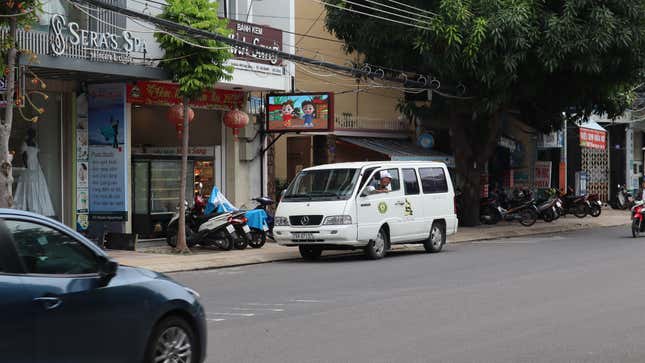
“Hey, is everything okay?” one of our group called to him. Sensing the jig was up, the minder walked up and urged us to return to the group.
“We just want to take pics of cars we don’t get at home. We’ll be back in a few minutes, we promise,” I insisted. I even invited him along with us if he was concerned for our safety. We continued our mini-exploration around Nha Trang.
Not 10 minutes later, another VinFast employee joined us, this one in an official security-looking outfit. “Please, let’s go back and enjoy the showcase,” the first employee said to us.
It didn’t feel like he was asking.
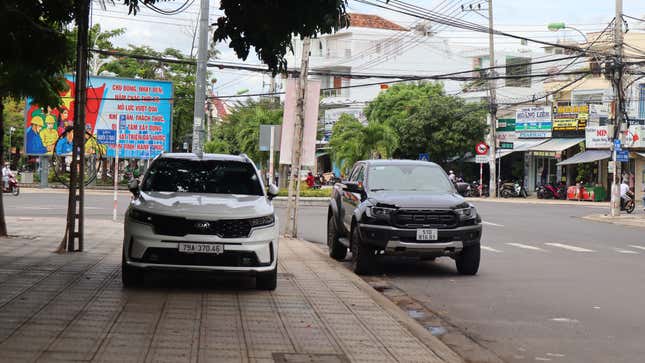
I’m sure Vingroup would say this was simply for our own safety. After all, foreign journalists getting lost, hurt, or hassled in Vietnam would be a pretty terrible black eye for VinFast. But the company’s insistence on recalling us to its loving arms felt more complicated than that. To me, it seemed like Vingroup would rather us be entertained only by what it could control. The company wanted us to experience its outrageous, larger-than-life projects. It threw us huge parties on private islands, complete with entertainment from big-name Vietnamese pop stars, and wanted us to be impressed by its barren yet grandiose VinUniversity. I couldn’t help but recall Tran Van Hoang, a Vietnamese automotive YouTuber who was visited by police and sued by VinFast after expressing complaints about his Lux A2.0 sedan.
Every brand works to control the narrative around its products. It’s why every major automaker engages in the same basic practice: flying journalists to a scenic location to wine and dine them and let them drive brand-new cars on a vetted route to write about the experience. But the way VinFast, and in turn Vingroup, handled that task felt maybe a little threatening. I didn’t fly halfway around the world for a university tour.
VinFast had spent hours entertaining us — including a wordless pantomime stage performance at dinner one night, featuring a projection-mapped castle claimed to have cost millions of dollars but identical to the tech used in student art projects at colleges everywhere — and we still hadn’t driven a single vehicle. It’s not that I didn’t appreciate the hospitality. I just wanted to learn whether the cars were any good.
If my initial drive of a pre-production VinFast VF8 the next day is anything to go by, the answer is: No, the cars are not very good at all.
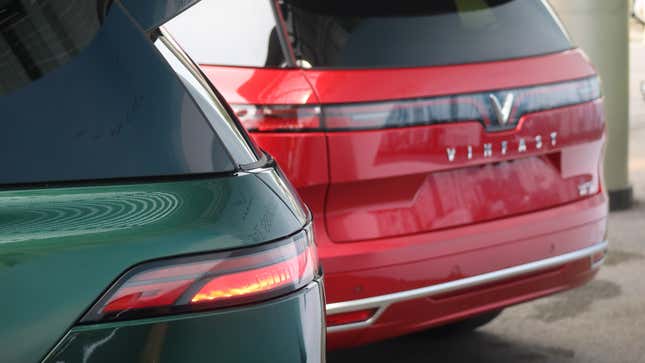
Our press drive took place on yet another private island owned by Vingroup: VinPearl Nha Trang. It’s Vingroup’s flagship property, home to the company’s Disney-like VinWonder amusement park. VinFast closed off a small section of the island for a controlled test drive route that I measured at about 2 kilometers — or less than 1.3 miles.
In front of VinPearl’s ornate convention center sat eight VinFast VF8s in two trim levels, Eco and Plus. Despite all the uncanny-valley showmanship, here we were, about to drive cars that were, in theory, nearly production ready. The brand ambassadors once again reiterated the company’s plans to ship vehicles to the US within a few weeks. Although the cars we were driving were Vietnamese spec, we were told “only a few software tweaks” would be required to make them ready for the US market.
I hope they do more than software tweaks. In its current state, the VF8 isn’t ready.
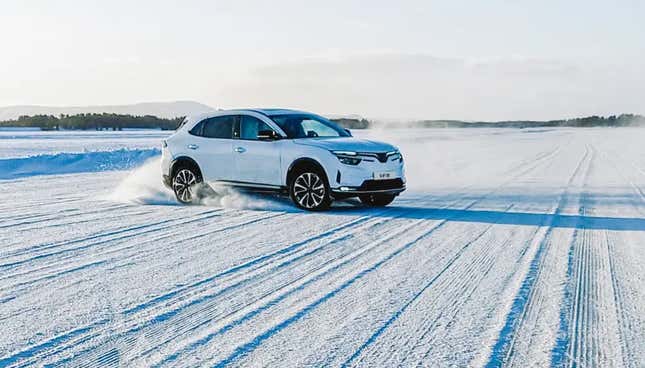
The VinFast VF8 is a compact-ish midsize EV crossover, with 350 horsepower in Eco trim and 402 HP in the Plus trim. Even with the generally higher curb weight inherent to an electric vehicle, 350 horsepower should be enough to scoot the VF8 around with authority. Yet throughout my time behind the wheel, the VF8 felt like it had barely half that output. I drove every pre-production vehicle VinFast brought to the event; all of them felt slow, and their performance was inconsistent.
The ride and handling were even worse. As VinFast bussed us from place to place, I noticed that company reps would always follow us in a few VF8s. Much of Vietnam’s highway system is brand-new and very smooth, but the VF8s were constantly bounding up and down, with poor suspension control that was visible from the bus. I shooed it away, figuring that the VinFast team was driving development mules that didn’t represent the near-final cars I was under the impression we would be driving.
Nope. Driving one VF8 after another around VinFast’s private island test course, my experience was exactly what I had seen as the VinFast folks tailed us around north Vietnam. Even on the island resort’s glass-smooth roads, the VF8 bucked and bounced as if the car was on cut springs. The steering was dead and nonlinear, paired with tires that gave up grip at the slightest bit of cornering verve, though I’m not sure how much of a dynamic impression one can get on a closed course on a private resort island.
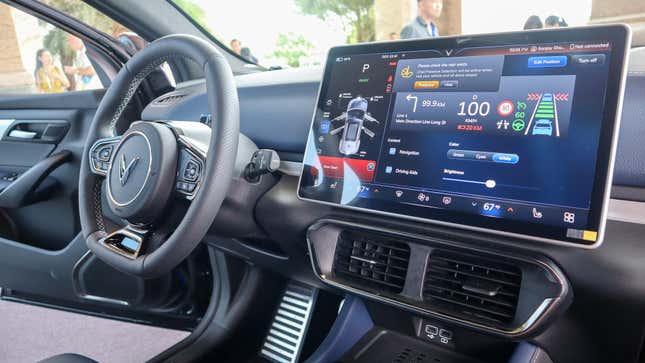
Annoyed, but still striving to be open-minded, I approached a VinFast engineering representative. Company spokespeople had claimed the VF8s we drove were Vietnamese production spec; I wanted to know what changes were in store for the US market. Yet again, the spokesperson reiterated that the VF8 was just a few software tweaks away from a US-market debut — implying that the chassis calibration was finalized.
To say I was frustrated would have been the biggest understatement east of the prime meridian. The brand had made such a big damn show — chartering a 20-hour flight, flexing on us with an almost haughty display of this automotive startup and its parent company’s reach into nearly every aspect of Vietnamese life. VinFast reps had bragged about beating their own internal timelines in getting these cars ready for mass production, and judging by the smiles on their faces, it seems like they were all genuinely psyched to show off a product they believed was ready to go toe-to-toe with established automakers. Instead, I’d been flown 8,000 miles to tootle around in a car that clearly wasn’t anywhere near done. I was pissed that the company had wasted my time.
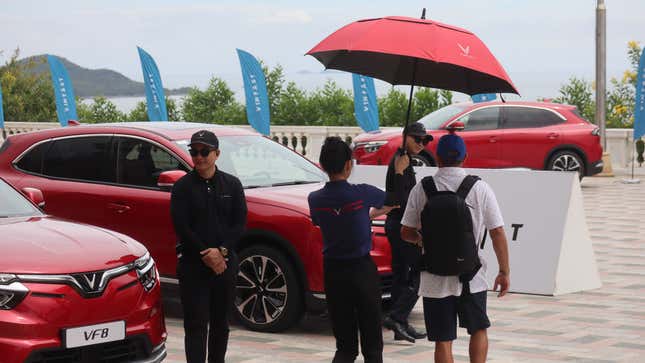
I decided to drive the other VF8 variant, the Plus model, said to have 402 horsepower. It, too, was dog-slow with crap ride quality. Not satisfied with my initial answers, I marched over to the gaggle of VinFast employees, trying to get to the bottom of the car’s poor performance. Eventually, I was led to a main engineer, someone who could answer substantial technical questions about the vehicle.
“So, this car has anywhere from 350 to 402 horsepower, right?” I asked the VinFast engineer. “Why is it so slow?”
“You mean peak horsepower,” he corrected me.
“What?”
“Peak horsepower. The VF8 only has 350 to 402 horsepower when the battery is above 80 percent charge,” the engineer said.
“You do realize that you’ll be the only manufacturer that limits power this severely, right?” I shot back. None of our test cars were fully charged, some of them hovering at 50 percent battery. Even then, that’s not an excuse. I have never driven an EV that reduced power output this dramatically at a routine state of charge. It didn’t seem right.
The VinFast engineers insisted I drive one specific prototype unit they claimed had the “latest and greatest” suspension and software updates. It, too, was pretty shit. The same bouncy, unfinished ride, the same dead steering, and it was only marginally quicker than the others. There were serious power delivery problems, too.

I had gotten tired of the dog and pony show, the over-the-top opulence, and the company’s inability to answer a question. Still, I tried to be diplomatic. I pulled aside VinFast’s U.S. public relations representative. “Baby, you gotta tell ‘em,” I said. “This car ain’t ready.” He reiterated the line I had heard so many times before: That the VF8s we were driving were pre-production models, and I should keep that in mind as I scrutinized their performance.
I’m not naive. I understand a PR rep’s job is to tell journalists what the company wants them to hear. But that’s not enough. In its current state, at the price VinFast wants to charge, the VF8 is a terrible deal. It feels like an underdeveloped, unfinished product that, quite frankly, would be an embarrassment in any market.
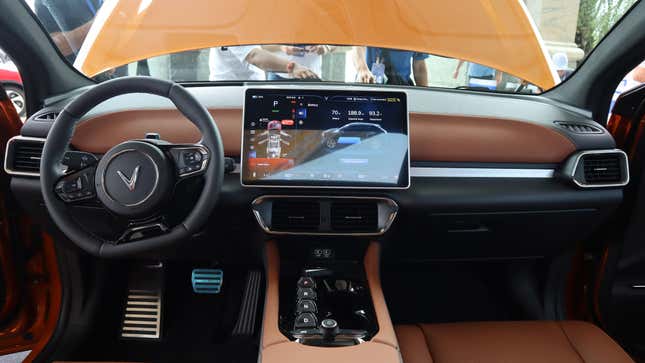
Throughout the entire trip, the VinFast representatives were super excited, certain that the company would meet its goal of beginning US deliveries in the fall. Outside the factory, completed VF8s and VF9s sat in parking lots, seemingly ready to be exported and delivered to customers. The brand wanted to ship ready-to-go cars to the US mere weeks, if not days, after our trip. If the pre-production units I drove were so far removed from what we’d be getting in the US, why bring me here? Why have journalists drive them at all?
Our test drive gave way to the closing dinner on the final night. Between the over-the-top (but astoundingly talented) performances by some of Vietnam’s biggest pop stars and the influencers in our group praising what was an egregiously bad vehicle, my open-minded outlook had taken a shotgun blast directly to the chest. I looked around at the overt displays of wealth, considered the cost of chartering the flights that brought us here, and tried to tabulate all the other enormous expenses involved in the show VinFast had put on for us, and for the three prior groups that had gotten identical tours. If VinFast had spent that money on vehicle development, could we have had a better VF8? Probably.
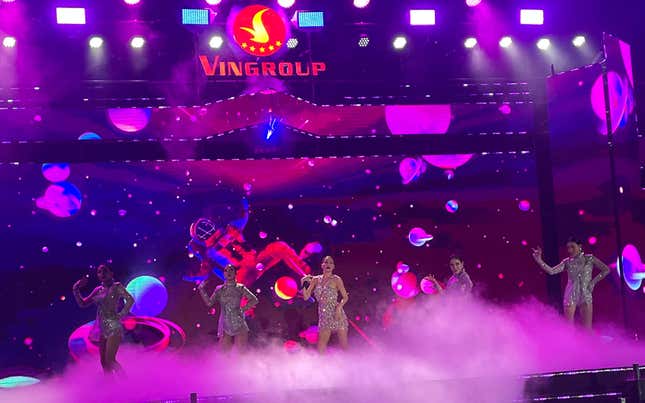
Still, as underbaked as the VF8 is in its current state, I can’t help but wonder if VinFast even has the ability to flop here. The larger VF9 looked a lot more impressive inside and out, although the automaker wouldn’t let us drive or even sit in that one. The company has a brand new factory and a vertically integrated operation; parts and batteries all come from the same Hai Phong manufacturing campus. In theory, supplier issues that have hobbled even the most established automakers might not affect VinFast. The new automaker is one arm of a giant conglomerate run by the richest man in Vietnam; the brand has unfathomably deep pockets, a different situation compared to so many EV startups that have failed right by the finish line due to lack of capital. VinFast appears to have the manufacturing capability to get cars into customers’ hands, something even Ford and Hyundai have struggled to do this year. Even if VinFast doesn’t fix anything on the VF8, there’s an ass for every seat, right?
Maybe. Tesla, Rivian, and Lucid have had their struggles making cars, but at the end of the day their products are very good. By comparison, VinFast’s efforts feel almost like early Hyundai and Kia; cheap, unrefined, underdeveloped, and not competitive. It took decades for the Korean automakers to shake that reputation; I don’t know if VinFast, or any brand that hopes to break into the mainstream, can afford to come out of the gate in 2022 without a home run.

As of this writing, VinFast says the first 999 US-market VF8s are on a boat that left Vietnam on November 25, en route to the United States. But according to a VinFast representative, the cars have not yet received CARB EO certification, which is required before vehicles can be delivered to customers in California or any other state that follows California’s vehicle regulations. Currently, VinFast has six store locations in the U.S., all in California. The VinFast representative also reiterated the brand’s goal to begin delivering VF8s to US customers “at the end of this year,” and confirmed that the VF9 is still undergoing federal tests and approvals required in the US market.
Whatever the deal, all I know is I flew more than 8,000 miles, learned nothing, and drove a car that was not ready for the United States. Good luck to VinFast, I guess.
